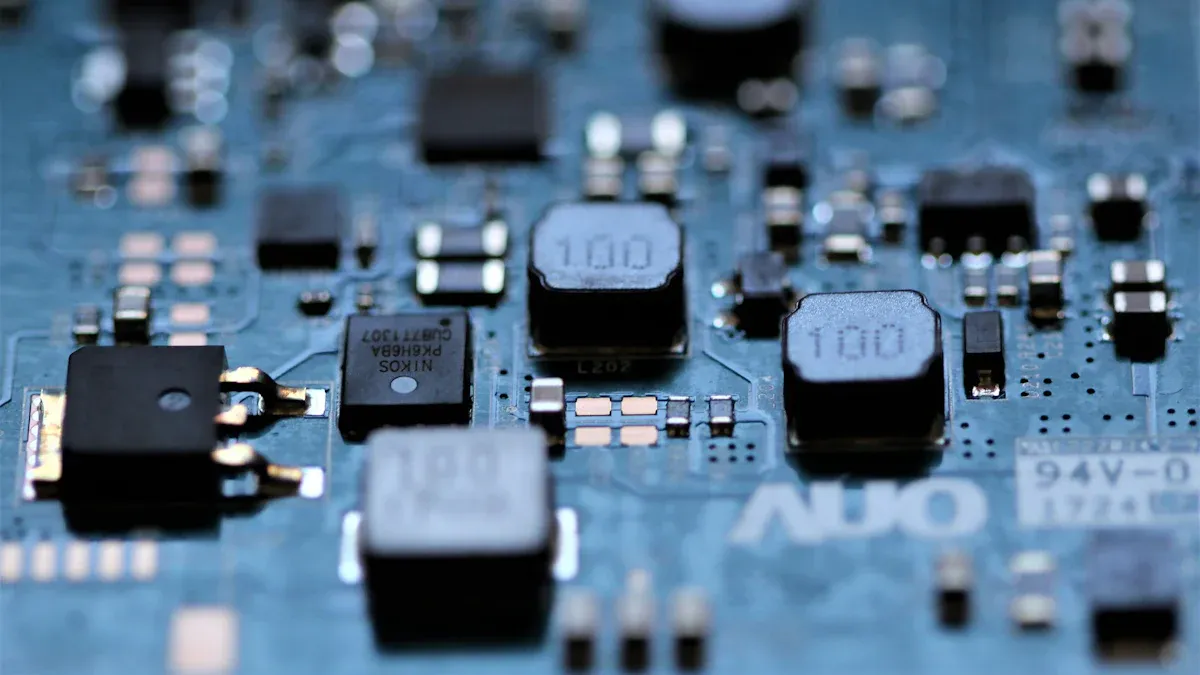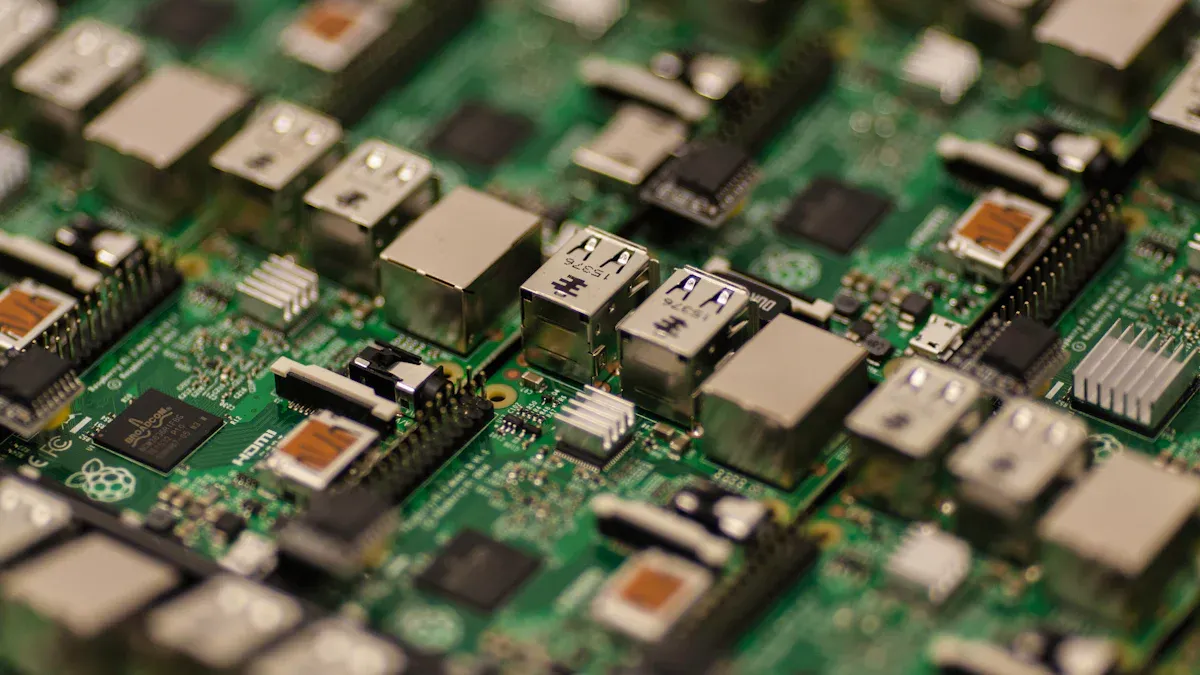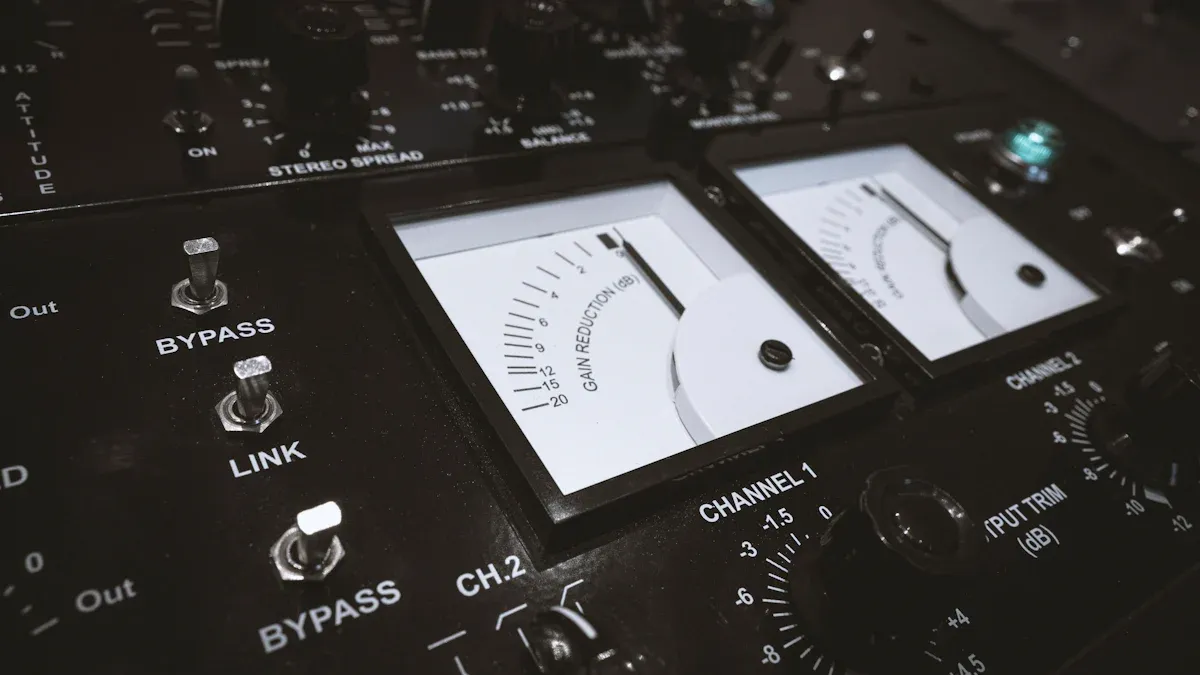What Are Analog Integrated Circuits and How Do They Work

You use analog integrated circuits every day, often without noticing. These tiny chips process continuous signals like sound from a microphone, light from a sensor, or changes in temperature. Analog integrated circuits work by handling real-world signals that do not have sharp steps or breaks. They use components such as transistors, resistors, and capacitors to amplify, filter, or convert these signals. This makes it possible for your devices to sense, react, and interact with the world around you.
Key Takeaways
Analog integrated circuits process smooth, real-world signals like sound, light, and temperature to help devices sense and react.
These circuits use components like amplifiers, voltage regulators, and comparators to boost, compare, and control signals.
You find analog ICs in many devices such as phones, audio systems, sensors, and industrial machines, making them smarter and safer.
Analog ICs differ from digital ones by handling continuous signals and working in real-time, while digital ICs use on/off states for data processing.
Designing analog ICs requires careful noise reduction, precise component matching, and smart layout to ensure accuracy and reliability.
Analog Integrated Circuits

What They Are
You can think of analog integrated circuits as the bridge between the real world and your electronic devices. These circuits process signals that change smoothly, like the sound of music, the brightness of a light, or the temperature in a room. Unlike digital circuits, which only understand on and off states, analog integrated circuits handle signals that flow in a continuous way. This makes them perfect for working with natural signals from the environment.
Note: Analog integrated circuits play a key role in devices that need to sense, measure, or control real-world conditions. You find them in audio systems, temperature sensors, and even in your phone’s microphone.
How They Work
Analog integrated circuits process continuous signals by using special building blocks. Each block has a job, such as making a weak signal stronger or comparing two voltages. You often see these circuits in action when a device needs to pick up a tiny signal from a sensor and turn it into something useful.
Here is a table showing the main functions of analog integrated circuits and how they help your devices:
Function Category | Description | Examples and Roles |
|---|---|---|
Amplification | Makes weak signals stronger so you can hear or see them better | Op-Amps boost audio signals in speakers and headphones |
Signal Comparison | Checks which of two signals is higher | Comparators protect circuits from too much voltage |
Voltage Regulation | Keeps voltage steady even if the power source changes | Voltage regulators keep your phone and computer running safely |
Frequency Synchronization | Matches the timing of signals for smooth communication | PLLs help your phone connect to networks and keep clocks accurate |
Signal Conditioning | Prepares signals for further processing or for sensors to read | Sensor interface circuits make sure temperature or light readings are accurate |
You rely on these functions every time you use a device that senses or reacts to the world. Analog integrated circuits respond quickly to changes, use little power, and work well in real-time situations.
Key Components
Inside analog integrated circuits, you find several important parts. Each one has a special job in processing signals:
Component | Role/Function | Additional Notes |
|---|---|---|
Operational Amplifiers (Op-Amps) | Change and filter signals; compare voltages | Used for boosting and shaping signals |
Voltage Regulators | Keep voltage levels steady | Essential for safe power supply |
Analog Switches and Multipliers | Direct signals to different parts of a circuit | Common in audio and measurement devices |
Comparators | Compare two voltages and decide which is higher | Used in safety and control circuits |
Change signals between analog and digital forms | Allow digital devices to work with real-world signals | |
Transistors, Resistors, Capacitors, Diodes | Form the basic building blocks for all signal processing | Enable amplification, filtering, and control |
Let’s look closer at the basic building blocks:
Resistors limit how much current flows and set the right conditions for other parts.
Capacitors store and release energy, filter signals, and smooth out changes.
Transistors act as amplifiers or switches, making signals stronger or turning them on and off.
These parts work together to shape, boost, and control the signals that flow through analog integrated circuits. For example, when you speak into a microphone, the circuit uses resistors and capacitors to clean up the signal, and transistors to make it loud enough for your phone to process.
Tip: Analog integrated circuits help your devices measure tiny changes, like a small rise in temperature or a faint sound. They make sure the data from sensors stays accurate and reliable.
Types
Amplifiers
You use amplifiers in many electronic devices. These circuits take a weak signal and make it stronger. For example, when you speak into a microphone, an amplifier boosts your voice so others can hear it clearly. Most amplifiers, like operational amplifiers (op amps), have two inputs: one that adds and one that subtracts. They can reach very high gain, sometimes up to 100,000 times the original signal. You find amplifiers in audio systems, radios, and even medical equipment.
Tip: Amplifiers help your devices pick up tiny signals and make them big enough to use.
Key features of amplifiers:
Very high input impedance, so they do not load down the signal source.
Low output impedance, which helps drive other circuits.
High common-mode rejection, which blocks unwanted noise.
Regulators
Voltage regulators keep the power in your devices steady. They compare the output voltage to a set reference and adjust it if it changes. This keeps your phone, computer, or TV running safely. Linear regulators use a transistor to drop extra voltage as heat, while switching regulators turn the power on and off quickly to save energy.
Main points about voltage regulators:
Maintain a constant output voltage, even if the input or load changes.
Use feedback loops to correct any changes.
Include safety features like overcurrent and thermal shutdown.
Voltage regulators are essential for reliable operation in all your electronics.
Comparators
Comparators check which of two signals is higher. When you need to know if a temperature is above a certain level, a comparator does the job. It outputs a digital signal—either high or low—based on the comparison. You see comparators in sensor circuits, motor controls, and measurement tools.
Common uses for comparators:
Control switches and circuit states.
Generate pulse-width modulation (PWM) signals for dimming lights or controlling motors.
Process sensor signals by comparing them to reference values.
Other Types
You also find other important analog ICs in electronics. Some examples include:
Typical Uses | |
|---|---|
Filters | Remove unwanted noise from audio or video signals |
Phase-Locked Loops | Synchronize clocks in communication systems |
Transceivers | Help devices talk to each other over networks |
Switches | Direct signals to different parts of a circuit |
These types work together to process, clean, and manage signals in your everyday devices.
Applications

Consumer Devices
You interact with analog integrated circuits every day in your favorite gadgets. These chips help your devices process sound, images, and touch. You find them in:
Audio systems, where audio amplifier ICs boost sound for speakers and headphones, making music and calls clearer.
Video processing ICs, which improve the image quality in TVs, cameras, and smartphones.
Embedded sensors in mobile phones, smartwatches, and home automation systems. These sensors enable features like touchscreens, step counters, and motion detection.
Power management ICs, which regulate voltage and extend battery life in portable electronics, keeping your devices running longer.
Analog ICs make your electronics smarter and more efficient by handling real-world signals like sound, light, and movement.
Industrial Uses
Analog integrated circuits play a big role in factories and automation. You see them in systems that measure, control, and protect machines. Here are some ways they help:
High-precision amplifiers measure voltage and current in robots and manufacturing equipment, ensuring accurate control.
Sensor transmitters improve measurement accuracy and use less power, making them perfect for temperature and pressure sensors.
Digital isolators keep signals safe and reliable, especially in high-voltage equipment.
Magnetic sensors detect motion and tampering, helping robots and machines work safely and efficiently.
These circuits help factories run smoothly, save energy, and keep workers safe.
Communication
Analog integrated circuits form the backbone of modern communication systems. They process signals in phones, computers, and network equipment. You rely on them for fast, clear connections.
Application Sector | 2024 Market Value (USD Billion) | 2035 Projected Value (USD Billion) | Role in Communication Devices and Infrastructure |
|---|---|---|---|
Telecommunication | 12.0 | 17.5 | Supports high-speed networks and infrastructure |
Consumer Electronics | 8.5 | 12.5 | Enables smart devices and energy efficiency |
Automotive | 5.0 | 7.5 | Powers safety and infotainment systems |
Industrial Automation | 3.0 | 4.5 | Improves control and productivity |
Healthcare | 2.44 | 3.0 | Delivers precise signal processing in devices |

You benefit from analog ICs every time you make a call, send a message, or connect to the internet. These chips amplify, convert, and regulate signals, making sure your communication devices work quickly and reliably.
Analog vs Digital ICs
Key Differences
You often hear about analog and digital integrated circuits, but they work in very different ways. Analog integrated circuits process signals that change smoothly, like the sound of your voice or the brightness of a light. These circuits handle a wide range of values, which makes them perfect for capturing real-world information. Digital integrated circuits, on the other hand, use only two states: 0 and 1. They process signals as a series of steps, not as a smooth flow.
Feature | Analog ICs | Digital ICs |
|---|---|---|
Signal Type | Discrete, only 0 and 1 | |
Processing Style | Synchronous, clock-driven | |
Noise Sensitivity | More sensitive to noise | Less sensitive, more robust |
Power Consumption | Lower in standby, efficient in real-time | Higher during active processing |
Application Examples | Audio, sensors, power management | Computers, memory, logic circuits |
You use analog integrated circuits when you need to measure or control things like temperature, sound, or light. These circuits give you high precision and fast response. Digital ICs shine when you need to store data, make decisions, or run complex programs. They are less affected by noise and can handle large amounts of information quickly.
Tip: Analog circuits are great for real-world signals, while digital circuits excel at data processing and storage.
Mixed-Signal ICs
Many modern devices need both analog and digital features. Mixed-signal ICs combine the best of both worlds on a single chip. You find these chips in smartphones, cars, and medical devices. They use special parts like analog-to-digital converters (ADCs) to turn real-world signals into digital data, and digital-to-analog converters (DACs) to change digital data back into signals you can hear or see.
Mixed-signal ICs include:
ADCs and DACs for signal conversion.
Digital logic for processing and control.
Power management circuits for efficient energy use.
These chips help your devices sense, process, and respond to the world around you. By combining analog and digital circuits, mixed-signal ICs make electronics more powerful and flexible. You get accurate measurements, fast processing, and reliable performance—all in one package.
Design Challenges
Noise
You face noise everywhere in analog integrated circuit design. Noise comes from many sources, such as thermal effects, flicker, and even the power supply. These unwanted signals can make it hard for your circuit to process real information. Noise can cause random voltage changes, distort signals, and lower the accuracy of your device.
Impact on Performance | How You Can Reduce It | |
|---|---|---|
Thermal Noise | Random fluctuations, limits small signals | Use low-noise parts, add filters |
Flicker Noise (1/f) | Distorts low-frequency signals | Choose proper amplifiers, optimize design |
Power Supply Transients | Causes voltage swings, affects stability | Add bypass capacitors, improve power layout |
Substrate Noise | Voltage changes from chip structure | Use differential circuits, optimize chip layout |
Tip: You can lower noise by picking high-quality components, adding bypass capacitors, and keeping analog and digital grounds separate. Careful layout helps keep noisy signals away from sensitive parts.
Precision
You want your analog circuits to measure and control signals with high accuracy. Achieving precision is not easy. Temperature changes, mismatched parts, and even small layout errors can cause drift and errors.
Use resistors and capacitors with low temperature coefficients to keep values steady.
Match components closely, sometimes to within 0.01%, to reduce errors.
Place matched parts close together to avoid temperature differences.
Design low-noise amplifiers with special transistors and resistors.
Use simulation tools to test your design before building it.
Precision matters most in devices like medical monitors or scientific instruments, where even a tiny error can make a big difference.
Layout
The way you arrange parts on a chip—called the layout—affects how well your circuit works. Long wires can slow signals and waste power. Crowded layouts can cause unwanted effects, like crosstalk or extra resistance.
Spread out cells to avoid unwanted interactions.
Check your layout with design rule checks and simulations.
Use special layout techniques to reduce layout-dependent effects, such as changes in transistor behavior.
Good layout helps your circuit work right the first time and makes it more reliable over time. Careful planning and checking can save you from costly mistakes later.
You rely on analog integrated circuits every day to connect your devices with the real world.
These circuits capture and process signals like sound, light, and temperature, making your electronics smarter and more responsive.
They remain essential as technology advances, supporting electric vehicles, healthcare, and 5G networks.
As digital systems grow, analog integrated circuits continue to deliver real-time, accurate data that digital circuits cannot handle alone. Appreciating their role helps you understand the foundation of modern electronics.
FAQ
What is the main difference between analog and digital ICs?
You process real-world signals with analog ICs. These signals change smoothly. Digital ICs handle signals as 0s and 1s. You use digital ICs for computers and memory. Analog ICs work best with sound, light, and temperature.
Why do you need analog ICs in modern devices?
You need analog ICs to connect your devices to the real world. They help your phone hear your voice, measure temperature, and control power. Without them, your devices cannot sense or react to changes around you.
Can you combine analog and digital circuits on one chip?
Yes! You use mixed-signal ICs for this. These chips let you process both analog and digital signals. You find them in smartphones, cars, and medical devices.
Tip: Mixed-signal ICs make your devices smarter and more flexible.
How do you reduce noise in analog ICs?
You can lower noise by using high-quality parts and careful design. Add bypass capacitors and keep wires short. Keep analog and digital grounds separate. This helps your circuits stay accurate and reliable.
See Also
Fundamentals And Uses Of Analog Integrated Circuit Design
Exploring Integrated Circuits And Their Impact On Electronics
How Fully Integrated Processors Function And Their Purpose
Understanding How Integrated Battery Monitor Circuits Operate
